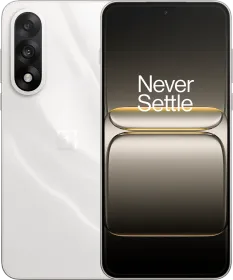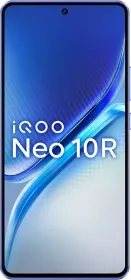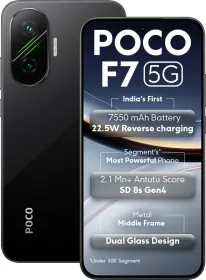The iQOO Neo 10 (review), launched in May, set a high bar in the mid-range segment, and now the POCO F7 aims to surpass it in value with similar features and a lower price. Both phones share the Snapdragon 8s Gen4 chipset, but the POCO F7’s top-end 12GB + 512GB variant is priced ₹2,000 lower than the iQOO Neo 10’s 12GB + 256GB variant. Yes, 256GB.
The POCO F7 also offers 4 years of OS updates and 6 years of security patches, compared to the iQOO Neo 10’s 3 years of OS updates and 4 years of security support. However, the iQOO Neo 10 promises better sustained performance, cameras, and an overall optimized user experience. In the comparison, we’ll examine everything from the design, display, performance, cameras, battery, software, and more to determine which device is the best under ₹35,000.
Design & Build

The POCO F7 features a metal frame and glass back with an IP68 rating for dust and water resistance. It measures 163.1 x 77.9 x 8.2mm, weighs 216g, and comes in Black, White, and Cyber Silver. The iQOO Neo 10 uses a plastic build with an IP65 rating, measuring 163.7 x 75.9 x 8.1mm and weighing 206g, available in Inferno Red and Titanium Chrome.

The POCO’s materials and higher IP rating offer better durability, while the iQOO’s plastic build isn’t very strong. The POCO includes Corning Gorilla Glass 7i for screen protection, while the iQOO’s glass type is unspecified. The iQOO Neo 10 is lighter than the F7, though.
Display
Both phones feature AMOLED displays with 1.5K resolution and HDR10+ support. The iQOO Neo 10 has a 6.78-inch panel with a 144 Hz refresh rate, 2000 nits HBM brightness (4500 nits peak), and 4320 Hz PWM dimming.

The POCO F7 offers a 6.83-inch display with a 120 Hz refresh rate, 1700 nits HBM brightness (3200 nits peak), 2160 Hz PWM dimming, and a 12-bit panel with Dolby Vision support. The iQOO’s display is clearly the better one here and I’ve used it enough to say that it is one of the best displays in the segment.

Performance

Both devices are powered by the Qualcomm Snapdragon 8s Gen4 (4nm) with an Adreno 825 GPU. The iQOO Neo 10 scores 2,405,000 on AnTuTu v10, slightly ahead of the POCO F7’s 2,084,535, per respective companies’ claims. The POCO F7 comes with 12GB LPDDR5X RAM and 256GB/512GB UFS 4.1 storage.
The iQOO Neo 10 offers more variants: 8GB/128GB (UFS 3.1), 8GB/256GB, 12GB/256GB, and 16GB/512GB (UFS 4.1). The iQOO has a larger vapor chamber than the POCO (7000mm² vs 6000mm²) and it shows. The iQOO Neo 10 handles sustained performance during gaming or heavy tasks very well, partly thanks to the Supercomputing Q1 chip as well. Both support Wi-Fi 7, dual SIM, and in-display fingerprint sensors.
Cameras
The POCO F7’s dual-camera setup includes a 50MP Sony IMX882 (f/1.5, 1/1.95-inch) with OIS and an 8MP Omnivision OV08F wide-angle lens (f/2.2), paired with a 20MP Omnivision OV20B selfie camera (f/2.2, 1/4-inch). It supports 4K video on the front but only 1080p on the rear.

The iQOO Neo 10 features a 50MP Sony IMX882 (f/1.79, 1/1.95-inch) with OIS, an 8MP wide-angle lens (f/2.2), and a 32MP selfie camera. It supports 4K video on both the front and the rear camera. The iQOO Neo 10 has the better setup here.

Battery & Charging

The iQOO Neo 10 has a 7,000 mAh silicon-carbon li-ion battery with 120W fast charging, achieving a full charge in approximately 30 minutes, but it lacks fast reverse charging. The POCO F7 features a larger 7,550mAh battery with 90W fast charging and 22.5W reverse wired charging for powering other devices.
Software

Both phones run Android 15 with different interfaces. The POCO F7 uses HyperOS, which has a customizable interface but with bloatware, supported by 4 years of OS updates and 6 years of security patches. The iQOO Neo 10 runs Funtouch OS 15, which includes some pre-installed apps and a less modern UI, with 3 years of OS updates and 4 years of security patches. Both devices come with a bunch of AI features, including Circle to Search.
Miscellaneous
The POCO F7 includes Dolby Atmos, Hi-Res Audio, stereo speakers, Bluetooth 6.0, NFC, and an IR blaster. Its IP68 rating and Gorilla Glass 7i offer better protection. The iQOO Neo 10 provides Hi-Res Audio, stereo speakers, Bluetooth 5.4, IR blaster, and NFC but lacks Dolby Atmos. Its IP65 rating is less robust. Both support advanced GPS (L1+L5), VoLTE, and dual-band Wi-Fi.
Pricing

- POCO F7:
- 12GB + 256GB: ₹31,999
- 12GB + 512GB: ₹33,999
- iQOO Neo 10:
- 8GB + 128GB: ₹31,999
- 8GB + 256GB: ₹33,999
- 12GB + 256GB: ₹35,999
- 16GB + 512GB: ₹40,999
The POCO F7’s 12GB + 256GB variant is much more affordable than the iQOO’s equivalent, offering better value.
POCO F7 vs. iQOO Neo 10: Summing Up

| Category | POCO F7 | iQOO Neo 10 |
| Dimensions | 163.1 x 77.9 x 8.2 mm | 163.7 x 75.9 x 8.1 mm |
| Weight | 216 g | 206 g |
| Build | Glass back, metal frame | Plastic back, plastic frame |
| IP Rating | IP68 | IP65 |
| Colors | Black, White, Cyber Silver | Inferno Red, Titanium Chrome |
| Screen Protection | Corning Gorilla Glass 7i | Unspecified |
| Display | 6.83-inch AMOLED, 1.5K (1289 x 2772), 448 PPI, 120 Hz, 12-bit, Dolby Vision, HDR10+, DCI-P3, 700 nits (typ), 1700 nits (HBM), 3200 nits (peak), 2160 Hz PWM | 6.78-inch AMOLED, 1.5K (1260 x 2800), 453 PPI, 144 Hz, 10-bit, HDR10+, DCI-P3, 2000 nits (HBM), 4500 nits (peak), 4320 Hz PWM |
| SoC | Snapdragon 8s Gen4, 4nm, 8-core (1x 3.21 GHz Cortex-X4 + 3x 3.0 GHz Cortex-A720 + 2x 2.8 GHz Cortex-A720 + 2x 2.02 GHz Cortex-A720) | Snapdragon 8s Gen4, 4nm, 8-core (1x 3.21 GHz Cortex-X4 + 3x 3.0 GHz Cortex-A720 + 2x 2.8 GHz Cortex-A720 + 2x 2.02 GHz Cortex-A720) |
| RAM | 12GB LPDDR5X | 8GB/12GB/16GB LPDDR5X |
| Storage | 256GB/512GB UFS 4.1 | 128GB (UFS 3.1), 256GB/512GB (UFS 4.1) |
| Cooling | 6000mm² | 7000mm² vapor chamber |
| Rear Cameras | 50MP Sony IMX882 (1/1.95-inch, f/1.5, OIS, AF, 4K30/60) + 8MP Omnivision OV08F (f/2.2, AF) | 50MP Sony IMX882 (1/1.95-inch, f/1.79, OIS, AF, 4K30/60) + 8MP (f/2.2, AF) |
| Selfie Camera | 20MP (1080p30) | 32MP (4K30/60) |
| Battery | 7550 mAh | 7000 mAh |
| Charging | 90W fast charging, 22.5W reverse wired charging | 120W fast charging |
| OS | HyperOS based on Android 15 | Funtouch OS 15 based on Android 15 |
| Updates | 4 years OS updates, 6 years security patches | 3 years OS updates, 4 years security patches |
| Pricing | 12GB + 256GB: ₹31,999; 12GB + 512GB: ₹33,999 | 8GB + 128GB: ₹31,999; 8GB + 256GB: ₹33,999; 12GB + 256GB: ₹35,999; 16GB + 512GB: ₹40,999 |
Verdict
The POCO F7 seems like the superior choice under ₹35,000, delivering a metal-glass design, HyperOS with AI features, larger battery, longer software updates, and a versatile camera system at a lower price. The iQOO Neo 10 remains competitive with a brighter 144 Hz display, 7,000mAh battery, and faster 120W charging. Now, which one would you pick? Let me know in the comments section below.
You can follow Smartprix on Twitter, Facebook, Instagram, and Google News. Visit smartprix.com for the latest tech and auto news, reviews, and guides.


































